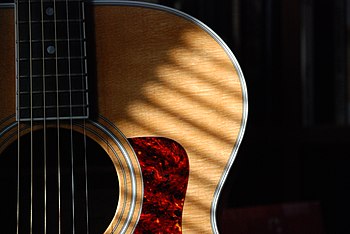Bar chords are the first advanced step for the guitar player. You have some kind of understanding of how to play open guitar chords and you have practiced till your fingertips are hardened enough not to hurt any more. So the next step is to learn the basic open chord shapes that move up the guitar neck to make bar chords and to start on the next stage of educating your left hand and arm in the art of guitar playing.
When you learn bar chords you will see that there are some basic chords that you have already learnt how to play that can be moved up the fretboard to form chords in more keys. The way we move open chords up the fretboard is by placing the first finger on the left hand across the guitar's neck and using the other fingers to complete the chord shape.
When you first try to play bar chords you will notice the change in sound. You have made all the guitar strings shorter, so they do not have the same amount of sustain and reverberation. The next thing you notice is that bar chords are painful. The pain should lessen as you practice but if it doesn't there are some things about your guitar playing you will need to look at.
First, if there is any adjustment needed to the way you press down on the strings with your left hand, you will need to relax your hand and experiment a little. Hold the chord shape but do not exert the pressure needed to make a clean sound. Now see if there is any tension in your arm. Just check to see if you can feel it. Go all the way up and down the arm fro the shoulder to the fingertips and relax any little areas of tension. This might result in some change in how you are holding your hand on the strings. As you try this checking for tension, also take note of if you hold your breath and clench your jaw. If you do either of those things, let the tension drop away in those areas.
Other areas that might need attention when you are looking for the easiest way to play bar chords are the height of your guitar's action and the need for hand exercises. You can do an online search for balls or other gizmos that you can use to help build finger strength, or for hand and finger strengthening exercises. But before you get too far into exercises, if your guitar's action is high you will need to press hard to make bar chords. Acoustic guitars have a relatively high action so the strings do not buzz. If you feel that your action might be too high you can adjust it by filing down the slots in your bridge so that the strings sit lower. If you make the strings too low you will need to buy another bridge bone.
If you are able to switch between acoustic and electric guitars you can clear up the question about your guitar's action because electric guitars have a lower action than acoustics. There are also tricks that you can use to avoid the pain of guitar chords, like using the open D fingering to move up the frets instead of using the open E shape to make a bar chord. This limits your chords to the top three strings. Also you can try loosening the tension on your strings or fooling around with open tunings, but do not go meddling with your guitar unless you are really sure you have some medical condition that stops you from playing bar chords. For now just assume that your hand will stop hurting once you have practiced enough.
|





